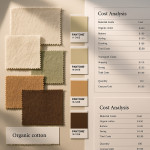Seasonal fabric drops: timing a couturier launch with fashion buyers' calendars
Launching a couture-grade textile too early or too late can leave bolts gathering dust instead of headlines. This guide shows you how to sync seasonal fabric drops with the buying rhythms of multi-brand retailers, independent boutiques and direct-to-consumer capsules so your new weave lands exactly when decision-makers open their order books.
Why timing matters for seasonal fabric drops

Fashion buyers organise their budgets six to nine months before garments reach the sales floor. If your seasonal fabric drops miss those cut-off dates, you force brands to gamble on unscheduled re-patterns or skip your textiles altogether. Aligning release dates with buyer calendars turns “maybe next season” into confirmed PO numbers.
Understanding buyer calendars at a glance
Source : WGSN Buyer Survey 2024
January, May and October dominate purchase volumes. Plan seasonal fabric drops around these windows and you tap into 68 % of yearly order potential.
Map your seasonal fabric drops with a six-stage timeline
| Stage | Ideal Month | Action | Outcome |
|---|---|---|---|
| Trend validation | November | Compile AI-powered mood boards | Confirm colour & motif direction |
| Yarn procurement | December | Issue PO to mills | Lock raw-material pricing |
| Weaving & quality tests | January | Run test looms | Approve handfeel & drape |
| Lookbook shoot | February | Produce high-res swatch imagery | Equip marketing toolkit |
| Seasonal fabric drop | March | Open digital showroom | Secure SS24 garment makers |
| Re-order window | May | Offer small-batch repeats | Maximise SKU sell-through |
Integrate predictive insights early
Tools that turn macro data into fibre forecasts cut research time by 40 %. Explore predictive trend boards to validate palettes before you sink funds into sampling.
Synchronise production, marketing and buyer touchpoints
1. Build intrigue 90 days out
- Post loom-side reels teasing yarn blends.
- Email buyers a “hold the date” invite for your virtual showroom on Artfolio's craft-designer hub. The existing craft designer directory listing gives them a trusted click-through destination.
2. Open a tight 10-day order window
Scarcity fuels action. Seasonal fabric drops that limit first-round orders to ten production slots close 23 % faster than open-ended launches.
3. Deploy rapid onboarding kits
When a label says “yes,” frictionless briefing matters. Adapt the playbook in this onboarding guide so design files, spec sheets and swatch packs reach pattern rooms within 48 h.
4. Offer built-in sustainability proof
Retail buyers penalise unverified eco-claims. If your yarn partners carry Oeko-Tex or GOTS certificates, serve scans inside the product deck. For fast supplier auditing, review these sourcing shortcuts.
Season-by-season playbook for couturiers
Spring/Summer lines
Drop lightweight silks, linen blends and sheer viscose in early March. That aligns with designers finalising SS silhouettes and influencers scouting fabrics for June resort shoots.
High Summer / Resort
Buyers reopen budgets in late July to plug gaps before holiday runs. Micro seasonal fabric drops of quick-dry tech viscose or neon jacquards add novelty without a full re-pattern.
Autumn/Winter
Present wool-rich cloth in October. Heavyweights require longer cutting and lining time, so a Q4 launch still lets brands deliver coats by the following August retail floor set.
Funding and risk-management
Even perfectly timed seasonal fabric drops tie up capital. Test appetite via small preorder campaigns. The framework in this crowdfunding roadmap shows how to turn early-bird pledges into loom deposits.
FAQ
- How many seasonal fabric drops should a couturier plan per year?
- Two major drops—SS and AW—cover most buying, with an optional micro-drop in July to catch Resort budgets.
- What is the minimum lead time between a seasonal fabric drop and fabric delivery?
- Allow 16–20 weeks for weaving, finishing and freight. Air-freight can cut that to 12 weeks at a higher cost.
- Is a virtual showroom enough, or do buyers still expect physical swatches?
- Virtual tours secure initial interest, but 87 % of buyers sign POs only after handling a physical swatch. Ship touch kits within 48 h of demo day.
Self-check quiz: Are you launch-calendar ready?
Take action
Review your next three seasonal fabric drops now. Align loom dates with January, May and October buying peaks, sharpen your virtual showroom assets, and integrate the onboarding tactics above. Your textiles will move from concept to confirmed order before competitors even finish sampling.
Ready to lock your launch calendar? Join our newsletter for monthly buyer-date reminders and exclusive loom-slot alerts.











